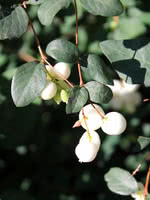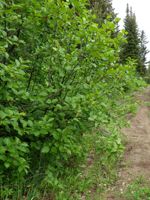Mon-Fri 9am - 5pm Mountain time
Western Snowberry vs Sitka Alder
Symphoricarpos occidentalis
Alnus alnobetula subsp. sinuata
NOT AVAILABLE THIS SEASON - MIGHT RETURN
CUSTOM GROW
Like the Common Snowberry, the Western Snowberry is a small shrub with pink flowers useful for feeding livestock and preventing erosion. Unlike the common species, however, the Western Snowberry is much more suited to wet conditions, capable of persevering through poor soil drainage and occasional flooding.
After the Snowberry's flowers have bloomed, it produces berries which often last on the plant through winter. These berries are toxic to humans, but livestock and local wildlife love them! Those hoping to attract wildlife to their property can plant Snowberry and expect to see animals foraging on it much later in the year than other plants.
Sitka Alder is a native deciduous shrub or small tree that often forms dense thickets. Its extensive root system stabilizes slopes and streambanks. Nitrogen-fixing capabilities and nutrient-rich leaf litter improve soil fertility, creating better growing conditions for surrounding plants. These qualities make it especially effective in disturbed or erosion-prone sites.
Often found in moist, high-elevation mountain environments, Sitka Alder also enhances habitat by providing cover and structure in both riparian and upland areas. Birds and small mammals utilize it for nesting, and its seeds serve as a food source.
Note: We use Sitka Alder for Alnus alnobetula subsp. sinuata. This species is also known by many other common names, including Mountain Alder, Green Alder, and others. Please confirm the scientific name to ensure you are ordering the correct plant.
Western Snowberry Quick Facts
Sitka Alder Quick Facts
Toxicity: berries are toxic to humans

